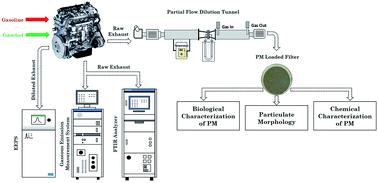当前位置:
X-MOL 学术
›
Environ. Sci.: Processes Impacts
›
论文详情
Our official English website, www.x-mol.net, welcomes your feedback! (Note: you will need to create a separate account there.)
Toxicity of exhaust particulates and gaseous emissions from gasohol (ethanol blended gasoline)-fuelled spark ignition engines.
Environmental Science: Processes & Impacts ( IF 5.5 ) Pub Date : 2020-06-23 , DOI: 10.1039/d0em00082e Avinash Kumar Agarwal 1 , Akhilendra Pratap Singh 1 , Tarun Gupta 2 , Rashmi Avinash Agarwal 3 , Nikhil Sharma 1 , Swaroop Kumar Pandey 4 , Bushra Ateeq 4
Environmental Science: Processes & Impacts ( IF 5.5 ) Pub Date : 2020-06-23 , DOI: 10.1039/d0em00082e Avinash Kumar Agarwal 1 , Akhilendra Pratap Singh 1 , Tarun Gupta 2 , Rashmi Avinash Agarwal 3 , Nikhil Sharma 1 , Swaroop Kumar Pandey 4 , Bushra Ateeq 4
Affiliation

|
In the last couple of decades, blending of oxygenated additives with gasoline has been advocated to reduce dependence on fossil fuels and to reduce hazardous health effects of gaseous emissions and particulate matter (PM) emitted by internal combustion (IC) engines in the transport sector worldwide. The primary objective of this research was to carry out a comparative analysis of exhaust PM emitted by gasohol (gasoline blended with 10% ethanol, v/v)-fulled spark ignition (SI) engine with that of baseline gasoline-fuelled SI engine. To assess the PM toxicity, physical, chemical and biological characterizations of PM were carried out using the state-of-the-art instruments and techniques. Measurements of regulated and unregulated gaseous species were also carried out at part/full loads. The results showed that the gasohol-fuelled engine emitted relatively lower concentrations of unregulated gaseous species such as sulfur dioxide (SO2), isocyanic acid (HNCO), etc. Physical characterization of exhaust particles revealed that the gasohol-fuelled engine emitted a significantly lower number of particles compared to the gasoline-fuelled engine. The presence of harmful polycyclic aromatic hydrocarbons (PAHs) and higher trace metal concentrations in PM emitted from the gasoline-fuelled engine was another important finding of this study. Biological characterizations showed that PM emitted from the gasohol-fuelled engine were less cytotoxic and had lower reactive oxygen species (ROS) generation potential. Mutagenicity of PM emitted from the gasohol-fuelled engine was also lower compared to that from the gasoline-fuelled engine. Overall, this study demonstrated that utilization of gasohol in SI engines led to the reduction in emissions, and lowering of PM toxicity, in addition to partial replacement of fossil fuels with renewable fuels.
中文翻译:

汽油(乙醇混合汽油)燃料的火花点火发动机产生的废气颗粒和气体排放物的毒性。
在过去的几十年中,提倡将含氧添加剂与汽油混合使用,以减少对化石燃料的依赖,并减少全球运输行业中内燃机(IC)排放的气体排放物和颗粒物(PM)的有害健康影响。 。这项研究的主要目的是对充满汽油的汽油点火(SI)发动机(与标准汽油汽油的SI发动机相比)进行汽油(与10%乙醇,v / v混合的汽油)排放的PM进行比较分析。为了评估PM的毒性,使用了最先进的仪器和技术对PM进行了物理,化学和生物学表征。还对部分/满负荷进行了调节气态和非调节气态的测量。2),异氰酸(HNCO)等排气颗粒的物理特征表明,汽油发动机比汽油发动机排放的颗粒数量少得多。这项研究的另一个重要发现是,汽油发动机排放的PM中有害多环芳烃(PAHs)的存在和较高的痕量金属浓度。生物学特性表明,汽油燃料发动机排放的PM的细胞毒性较小,而活性氧(ROS)的生成潜力较低。与汽油发动机相比,汽油发动机排放的PM的致突变性也较低。总体而言,这项研究表明,在SI发动机中使用汽油可以减少排放,并降低PM毒性,
更新日期:2020-07-23
中文翻译:

汽油(乙醇混合汽油)燃料的火花点火发动机产生的废气颗粒和气体排放物的毒性。
在过去的几十年中,提倡将含氧添加剂与汽油混合使用,以减少对化石燃料的依赖,并减少全球运输行业中内燃机(IC)排放的气体排放物和颗粒物(PM)的有害健康影响。 。这项研究的主要目的是对充满汽油的汽油点火(SI)发动机(与标准汽油汽油的SI发动机相比)进行汽油(与10%乙醇,v / v混合的汽油)排放的PM进行比较分析。为了评估PM的毒性,使用了最先进的仪器和技术对PM进行了物理,化学和生物学表征。还对部分/满负荷进行了调节气态和非调节气态的测量。2),异氰酸(HNCO)等排气颗粒的物理特征表明,汽油发动机比汽油发动机排放的颗粒数量少得多。这项研究的另一个重要发现是,汽油发动机排放的PM中有害多环芳烃(PAHs)的存在和较高的痕量金属浓度。生物学特性表明,汽油燃料发动机排放的PM的细胞毒性较小,而活性氧(ROS)的生成潜力较低。与汽油发动机相比,汽油发动机排放的PM的致突变性也较低。总体而言,这项研究表明,在SI发动机中使用汽油可以减少排放,并降低PM毒性,



























 京公网安备 11010802027423号
京公网安备 11010802027423号